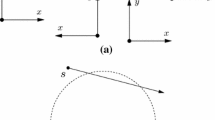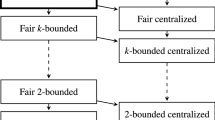Abstract
The design of distributed gathering and convergence algorithms for tiny robots has recently received much attention. In particular, it has been shown that the convergence problem, that is, the problem of moving robots close to each other (i.e., inside an area of some maximum size, where the position of the area is not fixed beforehand), can even be solved for very weak, oblivious robots: robots which cannot maintain state from one round to the next. The oblivious robot model is hence attractive from a self-stabilization perspective, where the state is subject to adversarial manipulation. However, to the best of our knowledge, all existing robot convergence protocols rely on the assumption that robots, despite being “weak”, can measure distances.
We in this paper initiate the study of convergence protocols for even simpler robots, called monoculus robots: robots which cannot measure distances. In particular, we introduce two natural models which relax the assumptions on the robots’ cognitive capabilities: (1) a Locality Detection (\(\mathscr {LD}\)) model in which a robot can only detect whether another robot is closer than a given constant distance or not, (2) an Orthogonal Line Agreement (\(\mathscr {OLA}\)) model in which robots only agree on a pair of orthogonal lines (say North-South and West-East, but without knowing which is which).
The problem turns out to be non-trivial, as simple strategies like median and angle bisection can easily increase the distances among robots (e.g., the area of the enclosing convex hull) over time. Our main contribution is deterministic self-stabilizing convergence algorithms for these two models. We also show that in some sense, the assumptions made in our models are minimal: by relaxing the assumptions on the monoculus robots further, we run into impossibility results.
S. Schmid—Trip to IIT Guwahati and research funded by the Global Initiative of Academic Networks (GIAN), an initiative by the Govt. of India for Higher Education.
Access this chapter
Tax calculation will be finalised at checkout
Purchases are for personal use only
Similar content being viewed by others
References
Cohen, R., Peleg, D.: Convergence properties of the gravitational algorithm in asynchronous robot systems. SIAM J. Comput. 34(6), 1516–1528 (2005)
Cohen, R., Peleg, D.: Convergence of autonomous mobile robots with inaccurate sensors and movements. SIAM J. Comput. 38(1), 276–302 (2008)
Wolfram Mathematica Documentation: BoxWhiskerChart (2010). http://reference.wolfram.com/language/ref/BoxWhiskerChart.html
Dolev, S.: Self-stabilization. MIT press, Cambridge (2000)
Flocchini, P., Prencipe, G., Santoro, N., Widmayer, P.: Distributed coordination of a set of autonomous mobile robots. In: Proceedings of the IEEE Intelligent Vehicles Symposium, pp. 480–485 (2000)
Flocchini, P., Prencipe, G., Santoro, N., Widmayer, P.: Hard tasks for weak robots: the role of common knowledge in pattern formation by autonomous mobile robots. ISAAC 1999. LNCS, vol. 1741, pp. 93–102. Springer, Heidelberg (1999). doi:10.1007/3-540-46632-0_10
Flocchini, P., Prencipe, G., Santoro, N., Widmayer, P.: Gathering of asynchronous robots with limited visibility. Theor. Comput. Sci. 337(1–3), 147–168 (2005)
Gilbert, S., Lynch, N., Mitra, S., Nolte, T.: Self-stabilizing robot formations over unreliable networks. ACM Trans. Auton. Adapt. Syst. 4(3), 17:1–17:29 (2009)
Izumi, T., Souissi, S., Katayama, Y., Inuzuka, N., Défago, X., Wada, K., Yamashita, M.: The gathering problem for two oblivious robots with unreliable compasses. SIAM J. Comput. 41(1), 26–46 (2012)
Prencipe, G.: Impossibility of gathering by a set of autonomous mobile robots. Theor. Comput. Sci. 384(2–3), 222–231 (2007)
Souissi, S., Défago, X., Yamashita, M.: Using eventually consistent compasses to gather memory-less mobile robots with limited visibility. TAAS 4(1), 9:1–9:27 (2009)
Sugihara, K., Suzuki, I.: Distributed algorithms for formation of geometric patterns with many mobile robots. J. Rob. Syst. 13(3), 127–139 (1996)
Suzuki, I., Yamashita, M.: Distributed anonymous mobile robots: formation of geometric patterns. SIAM J. Comput. 28(4), 1347–1363 (1999)
Author information
Authors and Affiliations
Corresponding author
Editor information
Editors and Affiliations
Rights and permissions
Copyright information
© 2017 Springer International Publishing AG
About this paper
Cite this paper
Pattanayak, D., Mondal, K., Mandal, P.S., Schmid, S. (2017). Convergence of Even Simpler Robots without Position Information. In: El Abbadi, A., Garbinato, B. (eds) Networked Systems. NETYS 2017. Lecture Notes in Computer Science(), vol 10299. Springer, Cham. https://doi.org/10.1007/978-3-319-59647-1_6
Download citation
DOI: https://doi.org/10.1007/978-3-319-59647-1_6
Published:
Publisher Name: Springer, Cham
Print ISBN: 978-3-319-59646-4
Online ISBN: 978-3-319-59647-1
eBook Packages: Computer ScienceComputer Science (R0)




